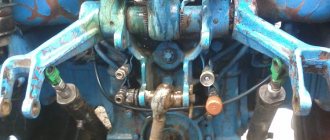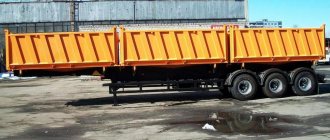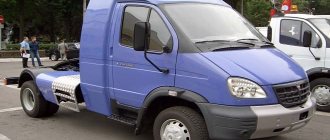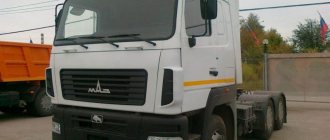The safety of the cargo and the safe movement of the vehicle on the road depend on the quality of the coupling. There are special services involved in organizing and supporting cargo transportation. The main goal of such companies is to control the movement of transportation objects (products, fuel, building materials, various raw materials). The coherence of the actions of carriers directly affects the continuity and stability of the functioning of large enterprises.
Even a layman understands how important a good coupling between a tractor and a semi-trailer is, because this factor enhances the efficiency of the machine. Coupling and uncoupling of the tractor must be carried out according to all the rules; the range of the upcoming trip should not play a decisive role: both when traveling around the city, and on a long journey between remote regions, the driver himself and the cargo he transports must be safe.
Persons who constantly work with trucks are required to understand the instructions describing the entire process of coupling the trailer and the tractor, and also be able to carry out the reverse operation. A driver who knows all the coupling rules by heart and follows them strictly will always have a car in order, and he will deliver the loads safe and sound. Such a truck driver is not afraid of any emergency situations during a trip.
The most scrupulous approach must be taken to the complex coupling of foreign-made tractors with a semi-trailer. The complexity of the procedure is easy to explain: often the mechanical structure of foreign trucks has its own differences compared to Russian vehicles. Such nuances must be taken into account. When planning to couple and uncouple a tractor, the driver must carefully familiarize himself with all the mechanical features of a foreign cargo vehicle.
General recommendations
Before coupling a tractor with a semi-trailer, carefully inspect the vehicle and make sure that all mechanisms are in working order. Particular care must be taken to inspect the fifth wheel of the tractor. Not only this structural unit must be in good condition, but also those elements with which the fixation is carried out. In order for the coupling to be carried out efficiently, you need to control the position of the saddle plate. It is important that there is nothing foreign on the saddle plate; it must be cleared of all unnecessary objects.
The driver can move on to coupling the tractor with the semi-trailer when he is sure that the semi-trailer is stationary and in a stable position. This can be achieved by applying the parking brakes. In this case, a support device will help you to be on the safe side. The semi-trailer is installed on a support in such a position that the level of the rolling plate is lower than the corresponding element of the fifth wheel mechanism. It is important to constantly check the condition of the connecting hoses and electrical wires. After all, during coupling, at the slightest violation of technology, there is a risk of an emergency. Safety regulations require that hoses and electrical cables be kept suspended on the machine.
General instructions
Before starting the hitch, it is worth checking the serviceability of the tractor unit and its mounting. All mechanisms must work, and there should be no unnecessary parts. All items used to create the reinforcement must be in good working order.
The condition for adhesion is the condition of a clean area of the saddle plate, with no unnecessary parts. Hitching is permitted only in a braked state using the parking brake. Braking can also be secured with fifth-wheel couplings.
It is also necessary to constantly monitor the location of rubber pipes and electrical wires, as they cause an emergency situation. To ensure safety, the wire can be hung on a support mechanism.
Algorithm of actions when coupling a tractor with a semi-trailer
Thanks to the clear instructions below, every driver will be able to hitch correctly. So, the main steps are:
- Fix the lever responsible for the release in the extreme forward position. Then you need to move the self-release fuse to the side.
- Drive the tractor slowly towards the semi-trailer in reverse. In this case, the semi-trailer's king pin must be completely inserted into the fifth wheel mechanism.
- Then you need to slow down.
- Check that the hitch lever is in the correct position (rearmost). The device that protects the connected elements from self-disengagement must close the rod during operation.
- Move the semi-trailer support to its highest position.
When carrying out the coupling procedure, important nuances of technology must be taken into account. So, if the semi-trailer has a single-line brake drive system, during coupling it is necessary to detach the hose and the black connecting head from the bracket, which is located on the wheel holder. Next, you need to fasten the heads in the correct order; on the tractor, you should unscrew the disconnect valve located near the base of the connecting hose.
The handle must be fixed so that it is in a position parallel to the axis. Be sure to check the position of the brake release valve located on the semi-trailer air distributor. He must be inhibited. The button is in a completely recessed state.
If the semi-trailer has a two-wire braking system or a combined one (one-wire and two-wire systems are present at once), Palm connecting heads are used during coupling; they will be red and blue in color. Then all steps are repeated in the same way as in the case of a single-wire system.
When the semi-trailer is securely fixed, the entire structure can begin to move. The parking brake can now be removed.
Privacy Policy
Privacy Policy
- General provisions
This privacy policy has been compiled in accordance with the requirements of the Federal Law of July 27, 2006. No. 152-FZ “On Personal Data” and determines the procedure for processing personal data and measures to ensure the security of personal data of the Limited Liability Company “Semi-trailer” (OGRN 1187746976560) (hereinafter referred to as the Operator).
1.1 The operator sets as its most important goal and condition for the implementation of its activities the observance of the rights and freedoms of man and citizen when processing his personal data, including the protection of the rights to privacy, personal and family secrets.
1.2 This privacy policy of the Operator (hereinafter referred to as the Policy) applies to all information that the Operator can obtain about visitors to the website https://polupritsep.rf/ (hereinafter referred to as the Site).
1.3. The User's use of the Site means acceptance of this Policy and the terms of processing of the User's personal data.
1.4. In case of disagreement with the terms of the Privacy Policy, the User must stop using the Site.
1.5. The Operator does not verify the accuracy of the personal data provided by the Site User.
1.6. This Privacy Policy directly applies only to the Site. The Operator does not control and is not responsible for third party sites that the User can access via links available on the Site.
- Basic concepts used in the Policy
2.1. Automated processing of personal data – processing of personal data using computer technology.
2.2. Blocking of personal data – temporary cessation of processing of personal data (except for cases where processing is necessary to clarify personal data).
2.3. Website is a collection of graphic and information materials, as well as computer programs and databases that ensure their availability on the Internet at the network address https://semitrailer.rf/.
2.4. Personal data information system is a set of personal data contained in databases and information technologies and technical means that ensure their processing.
2.5. Depersonalization of personal data - actions as a result of which it is impossible to determine without the use of additional information the ownership of personal data to a specific User or other subject of personal data.
2.6. Processing of personal data – any action (operation) or set of actions (operations) performed using automation tools or without the use of such means with personal data, including collection, recording, systematization, accumulation, storage, clarification (updating, changing), extraction, use, transfer (distribution, provision, access), depersonalization, blocking, deletion, destruction of personal data.
2.7. Operator - a state body, municipal body, legal or natural person, independently or jointly with other persons organizing and (or) carrying out the processing of personal data, as well as determining the purposes of processing personal data, the composition of personal data to be processed, actions (operations) performed with personal data.
2.8. Personal data – any information relating directly or indirectly to a specific or identified User of the website https://semitrailer.rf/.
2.9. Personal data authorized by the subject of personal data for distribution - personal data, access to an unlimited number of persons to which is provided by the subject of personal data by giving consent to the processing of personal data authorized by the subject of personal data for distribution in the manner prescribed by the Law on Personal Data (hereinafter referred to as personal data). data authorized for distribution).
2.10. User – any visitor to the website https://semi-trailer.rf/.
2.11. Providing personal data – actions aimed at disclosing personal data to a certain person or a certain circle of persons.
2.12. Dissemination of personal data - any actions aimed at disclosing personal data to an indefinite number of persons (transfer of personal data) or familiarizing with personal data to an unlimited number of persons, including the publication of personal data in the media, posting in information and telecommunication networks or providing access to personal data in any other way.
2.13. Cross-border transfer of personal data is the transfer of personal data to the territory of a foreign state to an authority of a foreign state, a foreign individual or a foreign legal entity.
2.14. Destruction of personal data – any actions as a result of which personal data are destroyed irrevocably with the impossibility of further restoration of the content of personal data in the personal data information system and (or) the material media of personal data are destroyed.
- Basic rights and obligations of the Operator
3.1. The operator has the right:
– receive from the subject of personal data reliable information and/or documents containing personal data;
– if the subject of personal data withdraws consent to the processing of personal data, the Operator has the right to continue processing personal data without the consent of the subject of personal data if there are grounds specified in the Law on Personal Data;
– independently determine the composition and list of measures necessary and sufficient to ensure the fulfillment of the obligations provided for by the Law on Personal Data and regulations adopted in accordance with it, unless otherwise provided by the Law on Personal Data or other federal laws.
3.2. The operator is obliged:
– provide the subject of personal data, at his request, with information regarding the processing of his personal data;
– organize the processing of personal data in the manner established by the current legislation of the Russian Federation;
– respond to requests and inquiries from personal data subjects and their legal representatives in accordance with the requirements of the Personal Data Law;
– report to the authorized body for the protection of the rights of personal data subjects, at the request of this body, the necessary information within 30 days from the date of receipt of such a request;
– publish or otherwise provide unrestricted access to this Policy regarding the processing of personal data;
– take legal, organizational and technical measures to protect personal data from unauthorized or accidental access, destruction, modification, blocking, copying, provision, distribution of personal data, as well as from other unlawful actions in relation to personal data;
– stop transfer (distribution, provision, access) of personal data, stop processing and destroy personal data in the manner and cases provided for by the Law on Personal Data;
– fulfill other duties provided for by the Personal Data Law.
- Basic rights and obligations of personal data subjects
4.1. Subjects of personal data have the right:
– receive information regarding the processing of his personal data, except for cases provided for by federal laws. The information is provided to the subject of personal data by the Operator in an accessible form, and it should not contain personal data relating to other subjects of personal data, except in cases where there are legal grounds for the disclosure of such personal data. The list of information and the procedure for obtaining it is established by the Law on Personal Data;
– require the operator to clarify his personal data, block it or destroy it if the personal data is incomplete, outdated, inaccurate, illegally obtained or not necessary for the stated purpose of processing, as well as take measures provided by law to protect their rights;
– put forward the condition of prior consent when processing personal data in order to promote goods, works and services on the market;
– to withdraw consent to the processing of personal data;
– appeal to the authorized body for the protection of the rights of personal data subjects or in court against unlawful actions or inaction of the Operator when processing his personal data;
– to exercise other rights provided for by the legislation of the Russian Federation.
4.2. Subjects of personal data are obliged to:
– provide the Operator with reliable information about yourself;
– inform the Operator about clarification (updating, changing) of your personal data.
4.3. Persons who provided the Operator with false information about themselves or information about another subject of personal data without the latter’s consent are liable in accordance with the legislation of the Russian Federation.
- The Operator may process the following personal data of the User:
5.1. Full Name;
5.2. Year, month, date and place of birth;
5.3. Email address;
5.4. Photos;
5.5. Phone numbers.
5.6. The site also collects and processes anonymized data about visitors (including cookies) using Internet statistics services (Yandex Metrica and Google Analytics and others).
5.7. The above data below in the text of the Policy are united by the general concept - “Personal Data”.
5.8. The Processing of special categories of personal data relating to race, nationality, political views, religious or philosophical beliefs, intimate life is not carried out by the Operator.
5.9. Processing of personal data permitted for distribution from among the special categories of personal data specified in Part 1 of Art. 10 of the Law on Personal Data is permitted if the prohibitions and conditions provided for in Art. 10.1 of the Personal Data Law.
5.10. The User’s consent to the processing of personal data permitted for distribution is issued separately from other consents to the processing of his personal data. In this case, the conditions provided for, in particular, Art. 10.1 of the Personal Data Law. Requirements for the content of such consent are established by the authorized body for the protection of the rights of personal data subjects.
5.11. The User provides consent to the processing of personal data permitted for distribution to the Operator directly.
5.12. The Operator is obliged, no later than three working days from the date of receipt of the specified consent of the User, to publish information about the conditions of processing, the existence of prohibitions and conditions for the processing of personal data permitted for distribution by an unlimited number of persons.
5.13. The transfer (distribution, provision, access) of personal data authorized by the subject of personal data for distribution must be stopped at any time at the request of the subject of personal data. This requirement must include the last name, first name, patronymic (if any), contact information (telephone number, email address or postal address) of the subject of personal data, as well as a list of personal data whose processing is subject to termination. The personal data specified in this requirement can only be processed by the Operator to whom it is sent.
5.14. Consent to the processing of personal data permitted for distribution terminates from the moment the Operator receives the request specified in clause 5.13. of this Policy regarding the processing of personal data.
5.15. The User agrees to the transfer of personal and other data to third parties, including for the purposes of their processing, to ensure the functioning of the Site, the implementation of affiliate and other programs, provided that the transferred data is subject to a regime similar to the regime existing on the Site, including , but not limited to, the transfer of personal data to persons affiliated with the Operator or who have entered into agreements with them, the Operator’s partners, companies included in the Operator’s group of companies, as well as third parties in cases where such transfer is necessary for the User to use a certain service or to perform a certain agreement or contract with the User.
5.16. In accordance with the provisions of the Federal Law of June 07, 2003 No. 126-FZ “On Communications” and in accordance with the provisions of the Federal Law of March 13, 2006 No. 38-FZ “On Advertising”, the User agrees to receive from The Operator, its partners, affiliates, companies included in the Operator group of companies, advertising and information mailings to a contact phone number, email address, in instant messengers by contact phone number, in the form of push notifications, in the form of phone calls, by checking the box -consent on the completed page of the Site, as well as by agreeing to receive push notifications.
- Principles for processing personal data
6.1. The processing of personal data is carried out on a legal and fair basis.
6.2. The processing of personal data is limited to the achievement of specific, pre-defined and legitimate purposes. Processing of personal data that is incompatible with the purposes of collecting personal data is not permitted.
6.3. It is not allowed to combine databases containing personal data, the processing of which is carried out for purposes that are incompatible with each other.
6.4. Only personal data that meets the purposes of their processing are subject to processing.
6.5. The content and volume of personal data processed correspond to the stated purposes of processing. Redundancy of the processed personal data in relation to the stated purposes of their processing is not allowed.
6.6. When processing personal data, the accuracy of personal data, their sufficiency, and, where necessary, relevance in relation to the purposes of processing personal data are ensured. The operator takes the necessary measures and/or ensures that they are taken to delete or clarify incomplete or inaccurate data.
6.7. The storage of personal data is carried out in a form that makes it possible to identify the subject of personal data, no longer than required by the purposes of processing personal data, unless the period for storing personal data is established by federal law, an agreement to which the subject of personal data is a party, beneficiary or guarantor. The processed personal data is destroyed or anonymized upon achievement of the processing goals or in the event of the loss of the need to achieve these goals, unless otherwise provided by federal law.
- Purposes of processing personal data
7.1. Purpose of processing the User’s personal data:
– informing the User about the Operator, its partners, affiliates, companies included in the Operator’s group of companies, about the projects it is developing, about services and products, by sending emails;
– conclusion, execution and termination of civil contracts;
– establishing feedback with the User, including: sending notifications, requests regarding the use of the Site, provision of services, sale of goods, payment, processing of requests and applications from the User;
– providing the User with customer and technical support in case of problems related to the use of the Site;
– providing the User with information on prices, news and information mailings and other information on behalf of the Operator or on behalf of the Operator’s partners;
– carrying out advertising activities;
– providing the User with access to the sites or functions of the Operator’s partners for the purpose of advertising and receiving products, updates, goods and services;
– providing the User with access to services, information and/or materials contained on the website https://semitrailer.rf/.
7.2. The Operator also has the right to send notifications to the User about new products and services, special offers and various events. The User can always refuse to receive information messages by sending the Operator an email to the email address marked “Opt-out of notifications about new products and services and special offers.”
7.3. Anonymized data of Users, collected using Internet statistics services, serves to collect information about the actions of Users on the site, improve the quality of the site and its content.
- Legal grounds for processing personal data
8.1. The legal grounds for the processing of personal data by the Operator are:
– Federal Law “On Information, Information Technologies and Information Protection” dated July 27, 2006 N 149-FZ;
– Federal Law “On Personal Data” dated July 27, 2006 N 152-FZ;
– statutory documents of the Operator;
– agreements concluded between the operator and the subject of personal data;
– federal laws, other regulations in the field of personal data protection;
– consent of Users to the processing of their personal data, to the processing of personal data permitted for distribution.
8.2. The Operator processes the User’s personal data only if it is filled out and/or sent by the User independently through special forms located on the website https://semi-trailer.rf/ or sent to the Operator via email. By filling out the appropriate forms and/or sending his personal data to the Operator, the User expresses his consent to this Policy.
8.3. The Operator processes anonymized data about the User if this is allowed in the User's browser settings (saving cookies and using JavaScript technology are enabled).
8.4. The subject of personal data independently decides to provide his personal data and gives consent freely, of his own free will and in his own interest.
- Conditions for processing personal data
9.1. The processing of personal data is carried out with the consent of the subject of personal data to the processing of his personal data.
9.2. The processing of personal data is necessary to achieve the goals provided for by an international treaty of the Russian Federation or law, to implement the functions, powers and responsibilities assigned by the legislation of the Russian Federation to the operator.
9.3. The processing of personal data is necessary for the administration of justice, the execution of a judicial act, an act of another body or official, subject to execution in accordance with the legislation of the Russian Federation on enforcement proceedings.
9.4. The processing of personal data is necessary for the execution of an agreement to which the subject of personal data is a party or beneficiary or guarantor, as well as for concluding an agreement on the initiative of the subject of personal data or an agreement under which the subject of personal data will be a beneficiary or guarantor.
9.5. The processing of personal data is necessary to exercise the rights and legitimate interests of the operator or third parties or to achieve socially significant goals, provided that the rights and freedoms of the subject of personal data are not violated.
9.6. The processing of personal data is carried out, access to an unlimited number of persons is provided by the subject of personal data or at his request (hereinafter referred to as publicly available personal data).
9.7. We process personal data that is subject to publication or mandatory disclosure in accordance with federal law.
- The procedure for collecting, storing, transferring and other types of processing of personal data
The security of personal data processed by the Operator is ensured by implementing legal, organizational and technical measures necessary to fully comply with the requirements of current legislation in the field of personal data protection.
10.1. The operator ensures the safety of personal data and takes all possible measures to prevent access to personal data by unauthorized persons.
10.2. The User’s personal data will never, under any circumstances, be transferred to third parties, except in cases related to the implementation of current legislation or in the event that the subject of personal data gives consent to the Operator to transfer data to a third party to fulfill obligations under a civil law contract.
10.3. If inaccuracies in personal data are identified, the User can update them independently by sending a notification to the Operator to the Operator’s email address marked “Updating personal data.”
10.4. The period for processing personal data is determined by the achievement of the purposes for which the personal data were collected, unless a different period is provided for by the contract or current legislation.
The User may at any time withdraw his consent to the processing of personal data by sending a notification to the Operator via email to the Operator's email address marked “Withdrawal of consent to the processing of personal data.”
10.5. All information that is collected by third-party services, including payment systems, communications and other service providers, is stored and processed by these persons (Operators) in accordance with their User Agreement and Privacy Policy. The subject of personal data and/or the User is obliged to independently familiarize himself with the specified documents in a timely manner. The operator is not responsible for the actions of third parties, including the service providers specified in this paragraph.
10.6. Prohibitions established by the subject of personal data on the transfer (except for providing access), as well as on processing or conditions for processing (except for gaining access) of personal data permitted for distribution, do not apply in cases of processing personal data in state, public and other public interests determined by law RF.
10.7. When processing personal data, the operator ensures the confidentiality of personal data.
10.8. The operator stores personal data in a form that makes it possible to identify the subject of personal data for no longer than required by the purposes of processing personal data, unless the period for storing personal data is established by federal law, an agreement to which the subject of personal data is a party, beneficiary or guarantor.
10.9. The condition for terminating the processing of personal data may be the achievement of the purposes of processing personal data, the expiration of the consent of the subject of personal data or the withdrawal of consent by the subject of personal data, as well as the identification of unlawful processing of personal data.
- List of actions performed by the Operator with received personal data
11.1. The operator collects, records, systematizes, accumulates, stores, refines (updates, changes), extracts, uses, transfers (distribute, provide, access), depersonalizes, blocks, deletes and destroys personal data.
11.2. The operator carries out automated processing of personal data with or without receiving and/or transmitting the received information via information and telecommunication networks.
- Cross-border transfer of personal data
12.1. Before the start of cross-border transfer of personal data, the operator is obliged to ensure that the foreign state into whose territory it is intended to transfer personal data provides reliable protection of the rights of personal data subjects.
12.2. Cross-border transfer of personal data to the territory of foreign states that do not meet the above requirements can only be carried out if there is written consent of the subject of personal data to the cross-border transfer of his personal data and/or execution of an agreement to which the subject of personal data is a party.
- Confidentiality of personal data
The operator and other persons who have access to personal data are obliged not to disclose to third parties or distribute personal data without the consent of the subject of personal data, unless otherwise provided by federal law.
- Final provisions
14.1. The User can receive any clarification on issues of interest regarding the processing of his personal data by contacting the Operator via email
14.2. This document will reflect any changes to the Operator’s personal data processing policy. The policy is valid indefinitely until it is replaced by a new version.
14.3. The current version of the Policy is freely available on the Internet at https://semi-trailer.rf/privacy-policy/.
CLOSE
How to prevent possible problems
Operating a machine with an attached semi-trailer may be accompanied by various malfunctions, which are caused by the following factors:
- brake pads or springs become unusable;
- small distance between the block and the drum;
- the connecting elements in the brake system are not hermetically sealed;
- The expansion fist may jam.
All problems in the process of coupling a tractor with a semi-trailer can be eliminated. Timely preventive examinations will help. It is necessary to evaluate all components of the tractor and semi-trailer; every little detail matters. Take the time to check and adjust the wheel hub bearings and see if the mounting nuts can reach the correct position.
Let's pick up a semi-trailer!
According to your parameters.From the parking lot or to order.
Synchronize the brake systems of both devices. This condition is especially important to observe if you are dealing with a foreign-made tractor. To avoid damage to the machine and semi-trailer, check the bending angle during the coupling process. When using a new semi-trailer, it must be run in before use. This is done so that some elements on which the quality of the coupling depend are worn in.
How to properly uncouple
When the driver has carried out the coupling, sooner or later he will have to carry out the reverse procedure. Uncoupling also needs to be done correctly in order to avoid possible damage to the semi-trailer or car. Read the instructions, which will explain each step of the process one by one.
- First you need to slow down.
- Uncoupling can only be done when the support device is secured as securely as possible and rests firmly on the road.
- Now you can unscrew the isolation valves that operate from the pneumatic system.
- Next, disconnect the connecting heads and then attach them to the wheel carrier bracket. After finishing the work, these elements are closed with special protective caps.
- When uncoupling, you must disconnect the plug that provides power to the equipment. It is removed from the plug socket installed on the tractor.
- Now you can remove the self-release safety device. The lever responsible for uncoupling is moved to the front extreme position.
After completing all the steps, all that remains is to drive the tractor away from the semi-trailer at low speed in the forward direction. This will complete the uncoupling of the two vehicles.
Step by step instructions
Regardless of the manufacturer, be it European tractors (Magnum, Man, Daf, Mercedes or Volvo), American (Fredliner) or Russian (Zil, Maz or Kamaz), coupling with semi-trailers is carried out in the same order:
- Preparation of vehicles.
- The semi-trailer is set to the parking brake, after which the supporting devices can be lowered and secured.
- Hitch.
- Connecting hoses and electrical wiring.
- Raising the support devices, releasing the trailer from the brake.
- Checking the reliability of the coupling.
Preparatory stage
Only serviceable equipment can be hitched, therefore, before carrying out any manipulations, the operation of the mechanisms is checked: the kingpin (a part of the turning units on the trailer in the form of a metal rod) and the coupling device (a semicircular steel plate on the frame of the tractor).
First of all, the condition of the saddle part - the main unit and elements for fastening - is assessed. The tractor seat is thoroughly cleaned of dirt, and foreign objects are removed from the surface.
The next step is to close the sides of the trailer and stabilize it using the parking brakes. Equipment must be hooked and unhooked on a flat, horizontal surface. Support mechanisms are used to securely fix the semi-trailer. The trailer knurl plate is leveled at or just below the tractor seat.
Hoses and wires are suspended from the tractor for safety.
Hitch
The process is carried out according to a specific algorithm, which includes several steps:
- The control lever is set to the extreme forward position, and the release safety device is moved to the side.
- Slowly the tractor moves backward until the semi-trailer kingpin is completely inserted into the saddle of the tractor. The coupling is carried out automatically. As soon as this happens, the trailer is immediately stopped by the parking brake.
- The reliability of the coupling of the road train is checked: the coupling control lever must be pulled back all the way, and the spontaneous release safety device must be set to the working position (blocks the rod).
- Connect the electrical wires and air hoses of the pneumatic drive, check the functionality of the systems.
- After the coupling is completed, the vehicle is released, the supporting devices are raised and secured, and the parking brake of the semi-trailer is released.
The last stage is to check the fastening, operation of the brakes and instruments.
Uncoupling
To disconnect the semi-trailer from the tractor, the following procedure is used:
- Place vehicles on the parking brake.
- Lower the support devices on the trailer as much as possible.
- Disconnect the electrical wiring cable, and the heads of the pneumatic brake drive in turn: first the supply line, then the control line, and close the covers. The hose is secured to the tractor.
- Raise the release safety lock and pull the control handle towards you until it locks. The strong locking bolt will then open the locking hook.
- Slowly unhitch the semi-trailer from the tractor, driving away in first gear until it is completely uncoupled.
Training for beginners
A novice driver of large trucks can learn experience from experienced truck drivers. Thus, a beginner is assigned to a professional and gradually accumulates his own experience. You can also watch a training video on a specialized website.
Once a novice driver confidently drives a road train and is able to control large vehicles around corners, he may be advised to take special courses. To learn how to hitch, a beginner will need to rent a cheap semi-trailer. Then he will be able to try his hand at using a machine that is optimal in terms of power and carrying capacity. However, a novice truck driver should always understand that no basic skills or even perfect knowledge of theory can replace the experience that is gained over time.











